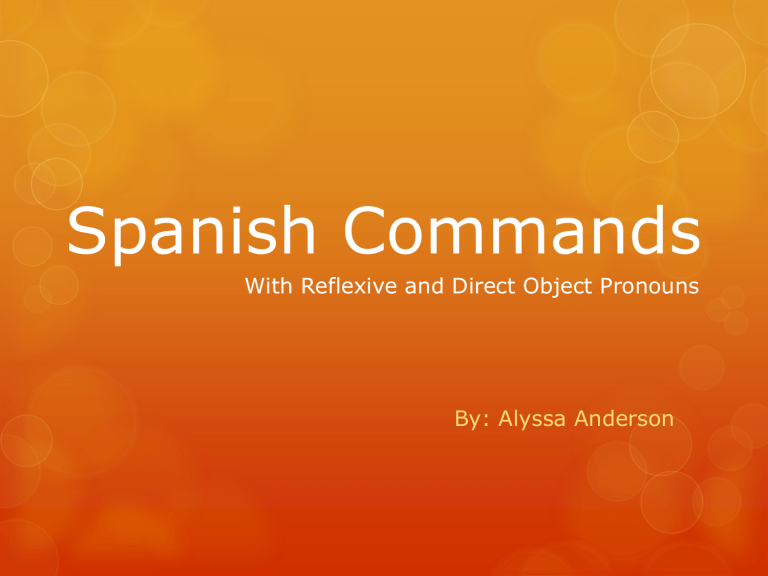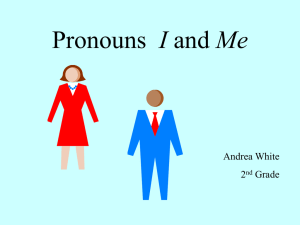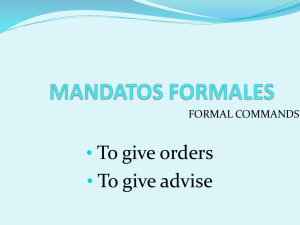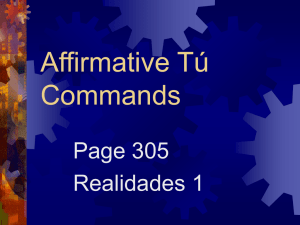Spanish Commands

Spanish Commands
With Reflexive and Direct Object Pronouns
By: Alyssa Anderson
Types of Commands
Lets start with commands. There are two different types of commands, formal commands and informal commands. Formal commands are for people that you don’t know very well.
Informal commands are for people you know well. For each type of command there are affirmative and negative commands, both using separate rules.
Formal Commands
Formal commands are for people you don’t know well. The Spanish subjects that are used for these commands are:
• Usted
• Ustedes
• And for plurals
Affirmative Formal Commands
There are three easy steps to remember:
1.
Conjugate for yo
2.
Drop the “o”
3.
Add the opposite ending
-ar e, en -er/ir a,an
Example:
Verb: Nadar –to swim Subject: Usted
1.
Nado
2.
Nad
3.
¡Nade!
Negative Formal Commands
The first three steps are the same as affirmative commands but with one simple step added at the end
1.
Conjugate for yo
2.
Drop the “o”
3.
Add the opposite ending
-ar e, en -er/ir a,an
4. Place no before the verb
Example:
Verb: Bailar –to dance Subject: Ustedes
1.
Bailo
2.
Bail
3.
Bailen
4.
¡No bailen!
Informal Commands
Informal commands are for people you know well. The only subject that we use informal commands for is tú.
We don’t know the nosotros command form. If there are plural people you know that you are giving a command to use the formal command for ustedes.
Affirmative Informal Commands
There are also three easy steps to remember for informal commands:
1.
Conjugate for yo
2.
Drop the “o”
3.
Add the third person ending
-ar a -er/ir e
Example:
Verb: Comer –to eat Subject: Tú (always will be for informal)
1.
Como
2.
Com
3.
¡Come!
Negative Informal Commands
The same steps that are for affirmative are very similar for the negative:
1.
Conjugate for yo
2.
Drop the “o”
3.
Add these endings:
-ar es -er/ir as
4. Place no in front of the verb
Example:
Verd: Caminar –to walk Subject: Tú
1.
Camino
2.
Camin
3.
Camines
4.
¡No Camines!
Commands with Pronouns
There are two different types of pronouns that our Spanish II class uses, Direct Object Pronouns and
Reflexive pronouns. Both have VERY similar steps to follow with the formal and informal commands.
Reflexive Pronouns
Reflexive pronouns are used to say a verb acts on the subject.
Example:
I hit myself.
Bill hit himself.
They hit themselves.
The verb acts on all of the subjects.
Reflexive Pronouns
Yo
Tú
Me Nos
Te Os
Usted Se Se
Él Se Se
Ella Se Se
Nosotros
Vosotros
Ustedes
Ellos
Ellas
Example:
-I shower are 5:30.
Yo me ducho a las cinco y media.
-We dress at 8:00.
Nostoros nos vestimos a las ocho.
Reflexive Pronouns with Formal Commands
Affirmative
The first three steps are the same with a few twists at the end:
1.
Conjugate for yo
2.
Drop the “o”
3.
Add the opposite ending
-ar e, en -er/ir a,an
4. Add the reflexive pronoun “se” to the end
5. Add an accent mark to the 3 rd syllable from the end
Example:
Verb: Dormirse –to sleep Subject: Usted
1.
Duermo 4. Duermase
2.
Duerm 5. ¡ Du é rmase !
3.
Duerma
Reflexive Pronouns with Formal Commands
Negative
The first three steps are the same:
1.
Conjugate for yo
2.
Drop the “o”
3.
Add the opposite ending
-ar e, en -er/ir a,an
4.
Put no and se in front of the verb
5.
Example:
Verb: Ducharse –to take a shower Subject: Usted
1.
Ducho 4. ¡No se duchen!
2.
Duch
3.
Duchen
Reflexive Pronouns with Informal Commands
Affirmative
The first three steps are the same with a few twists at the end:
1.
Conjugate for yo
2.
Drop the “o”
3.
Add the third person ending
-ar a -er/ir e
4. Add the reflexive pronoun “te” to the end
5. Add an accent mark to the 3 rd syllable from the end
Example:
Verb: Dormirse –to sleep Subject: Tú
1.
Duermo 4. Duermete
2.
Duerm
3.
Duerme
5. ¡ Duérmete!
Reflexive Pronouns with Informal Commands
Negative
The first three steps are the same with a few twists at the end:
1.
Conjugate for yo
2.
Drop the “o”
3.
Add the third person ending
-ar as -er/ir es
4. Put no and te in front of the verb
Example:
Verb: afeitarse –to shave Subject: Tú
1.
Afeito 4. ¡No te afeitas!
2.
Afeit
3.
Afeita
Direct Object Pronouns
Direct object pronouns are used to take the place of things. The object is directly affected by the verb.
These are the direct object pronouns:
It Them lo los la las
These always come before the conjugated verb or attaches to the infinitive.
Example:
-We read the books.
Nosotros los leemos
-She listens to music.
Ella la escucha.
Direct Object Pronouns with Formal Commands
Affirmative
The first three steps are the same with a few twists at the end:
1.
Conjugate for yo
2.
Drop the “o”
3.
Add the opposite ending
-ar e, en -er/ir a,an
4. Add the direct object pronoun to the end
5. Add an accent mark to the 3 rd syllable from the end
Example:
Verb: Lavar –to wash (Wash it) Subject: Usted
1.
Lavo 4. Lavalo
2.
Lav
3.
Lava
5. ¡Lávalo!
Direct Object Pronouns with Formal Commands
Negative
The first three steps are the same:
1.
Conjugate for yo
2.
Drop the “o”
3.
Add the opposite ending
-ar e, en -er/ir a,an
4.
Put no and the direct object in front of the verb
5.
Example:
Verb: Beber –to drink (Drink it) Subject: Ustedes
1.
Bebo
2.
Beb
4. ¡No lo beban!
3.
Beban
Direct Object with Informal Commands
Affirmative
The first three steps are the same with a few twists at the end:
1.
Conjugate for yo
2.
Drop the “o”
3.
Add the third person ending
-ar a -er/ir e
4. Add the direct object pronoun to the end
5. Add an accent mark to the 3 rd syllable from the end
Example:
Verb: Comer-to eat (Eat them) Subject: Tú
1.
Como 4. Comalos
2.
Com 5. ¡Cómalos!
3.
Coma
Direct Object Pronouns with Informal Commands
Negative
The first three steps are the same with a few changes at the end:
1.
Conjugate for yo
2.
Drop the “o”
3.
Add the third person ending
-ar as -er/ir es
4. Put no and the direct object in front of the verb
Example:
Verb: Cerrar –to close (Don’t close it) Subject: Tú
1.
Cerro 4. ¡No lo cerras!
2.
Cerr
3.
Cerra
Review
Formal Commands
Affirmative
1.
Conjugate for yo
2.
Drop the “o”
3.
Add the opposite ending
-ar e, en -er/ir a,an
4. Add the pronoun to the end
5. Add an accent mark to the
3 rd syllable from the end
Negative
1.
Conjugate for yo
2.
Drop the “o”
3.
Add the opposite ending
-ar e, en -er/ir a,an
4. Place no and the pronoun before the verb
Informal Commands
Affirmative
1.
Conjugate for yo
2.
Drop the “o”
3.
Add the third person ending
-ar a -er/ir e
4. Add the pronoun to the end
5. Add an accent mark to the
3 rd syllable from the end
Negative
1.
Conjugate for yo
2.
Drop the “o”
3.
Add these endings:
-ar es -er/ir as
4. Place no and the pronun before the verb
Quiz:
Use direct objects or reflexive pronouns with commands to write sentences.
1. Tell your best friend to brush their teeth.(cepillarse los dientes)
¡Cepíllate los dientes!
2. Tell your brother to wash the dishes. (lavar los platos)
¡Lávalos!
3. Tell your teacher not to sleep in class.(dormirse en clase)
¡No se duerma en clase!
4. Tell your parents friends to sit down. (sentarse)
¡Siéntense!
5. Tell the stranger not to take the taxi. (tomar el taxi)
¡No lo tome!








